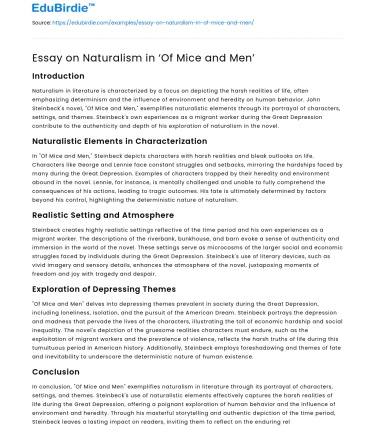Introduction
Naturalism in literature is characterized by a focus on depicting the harsh realities of life, often emphasizing determinism and the influence of environment and heredity on human behavior. John Steinbeck's novel, "Of Mice and Men," exemplifies naturalistic elements through its portrayal of characters, settings, and themes. Steinbeck's own experiences as a migrant worker during the Great Depression contribute to the authenticity and depth of his exploration of naturalism in the novel.
Naturalistic Elements in Characterization
In "Of Mice and Men," Steinbeck depicts characters with harsh realities and bleak outlooks on life. Characters like George and Lennie face constant struggles and setbacks, mirroring the hardships faced by many during the Great Depression. Examples of characters trapped by their heredity and environment abound in the novel. Lennie, for instance, is mentally challenged and unable to fully comprehend the consequences of his actions, leading to tragic outcomes. His fate is ultimately determined by factors beyond his control, highlighting the deterministic nature of naturalism.
Save your time!
We can take care of your essay
- Proper editing and formatting
- Free revision, title page, and bibliography
- Flexible prices and money-back guarantee
Realistic Setting and Atmosphere
Steinbeck creates highly realistic settings reflective of the time period and his own experiences as a migrant worker. The descriptions of the riverbank, bunkhouse, and barn evoke a sense of authenticity and immersion in the world of the novel. These settings serve as microcosms of the larger social and economic struggles faced by individuals during the Great Depression. Steinbeck's use of literary devices, such as vivid imagery and sensory details, enhances the atmosphere of the novel, juxtaposing moments of freedom and joy with tragedy and despair.
Exploration of Depressing Themes
"Of Mice and Men" delves into depressing themes prevalent in society during the Great Depression, including loneliness, isolation, and the pursuit of the American Dream. Steinbeck portrays the depression and madness that pervade the lives of the characters, illustrating the toll of economic hardship and social inequality. The novel's depiction of the gruesome realities characters must endure, such as the exploitation of migrant workers and the prevalence of violence, reflects the harsh truths of life during this tumultuous period in American history. Additionally, Steinbeck employs foreshadowing and themes of fate and inevitability to underscore the deterministic nature of human existence.
Conclusion
In conclusion, "Of Mice and Men" exemplifies naturalism in literature through its portrayal of characters, settings, and themes. Steinbeck's use of naturalistic elements effectively captures the harsh realities of life during the Great Depression, offering a poignant exploration of human behavior and the influence of environment and heredity. Through his masterful storytelling and authentic depiction of the time period, Steinbeck leaves a lasting impact on readers, inviting them to reflect on the enduring relevance of naturalism in literature and its portrayal of the human condition.






 Stuck on your essay?
Stuck on your essay?

